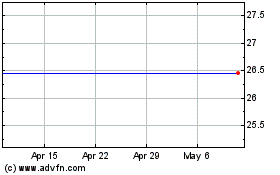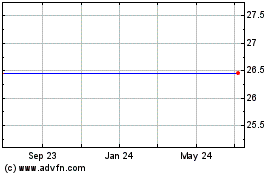Postal Savings Bank of China Raises $7 Billion Ahead of IPO--Update
December 09 2015 - 2:44AM
Dow Jones News
By Chuin-Wei Yap
BEIJING--Postal Savings Bank of China Co. raised $7 billion from
a star-studded roster of investors ranging from global financial
institutions to domestic Internet giants, as the country's largest
unlisted lender moved ahead with plans for a likely $10 billion
initial public offering that would advance Beijing's
corporate-reform agenda.
Postal Savings, the sixth-largest lender in China by assets,
plans to list shares in Hong Kong next year, making it the largest
Chinese bank aiming to go public in coming months, amid a wave of
others. The trend comes as mounting bad debt and slowing economic
growth cloud the outlook for Chinese banks as they need fresh
avenues of funding.
Postal Savings said it sold a nearly 17% stake for 45.1 billion
yuan to a group that includes foreign investors UBS Group AG, J.P.
Morgan Chase & Co., International Finance Corp., Canada Pension
Plan Investment Board, Singapore firms DBS Bank Ltd. and Temasek
Holdings.
The group's Chinese members include Ant Financial Services
Group, the financial affiliate of Alibaba Group Holding Ltd.;
Tencent Holdings Ltd.; China Life Insurance Co. and China Telecom
Corp.
Postal Savings and its investors said Wednesday that the deal
would help its efforts to modernize corporate governance and
financial management. J.P. Morgan Chase said it would provide
support and expertise to Postal Savings.
"Postal Savings Bank needs to enhance its high-risk management
capabilities as it faces complicated global and economic changes,"
said Postal Savings President Lu Jiajin, calling the deal the
single largest strategic fundraising among Chinese financial
institutions.
Postal Savings, a hybrid between a commercial and policy bank
along the lines of Japan Post Bank Co., said foreign investors
would help to broaden its international market and boost global
business. Mr. Lu said the bank plans to list on both foreign and
domestic exchanges. China's biggest banks are typically listed in
Hong Kong and Shanghai.
With more than 40,000 branches all over China, Postal Savings
has a network twice the size of Industrial & Commercial Bank of
China Ltd., China's largest bank by assets. It has access to
depositors across rural China and greater ability to reach
borrowers that China's biggest publicly listed banks have
traditionally shunned, including farmers and small-scale
entrepreneurs. The lender says it already has expertise in
microfinance, a segment of lending that targets small borrowers. It
is also working to refine a suite of financial services including
wealth-management products for its 490 million customers.
Ant Financial said it has been working with Postal Savings in
recent years to develop microloans, among other items.
"Postal Savings Bank is ambitious," said Dragon Tang, an
associate professor of finance at the University of Hong Kong. "It
is an active player in the securitization market and is serious
about risk management. Bringing the bank to IPO would be a
milestone and can get [it] some political capital."
Postal Savings faces some challenges comparable with its
Japanese peer, analysts say. It has a relatively high cost of
staffing and maintaining its many branches. It faces competition in
turning its sprawling network into a strategic advantage, as
domestic e-commerce companies have already made inroads into
developing electronic-payment systems nationwide. In its role as a
sometime policy bank, Postal Savings is also obliged to finance
projects that the government wants regardless of the project's
returns.
The bank said in April it owns more than 6.3 trillion yuan in
assets.
The IPO would also come as banks world-wide look to shore up
their balance sheets to meet more rigorous stress tests. Mr. Tang
said the IPO would help the bank meet Basel III regulations, a set
of voluntary global limits on bank capital adequacy.
The amount of funds it is targeting for its IPO would depend on
market conditions at the time of the launch, Mr. Lu said. Postal
Savings is currently fully owned by the national postal service
China Post Group Corp.
Midsize lenders have struggled in the past two months to
overcome investor doubts, especially about nonperforming loans
among Chinese banks. Bank of Qingdao raised $607 million last
month, at the lower end of the expected price range. Bank of
Jinzhou Co.'s IPO last month was also priced at the bottom of its
range.
Bad loans reached 0.82% of total loans at Postal Savings at the
end of September, the bank said Wednesday. That is well below the
1.59% average for commercial banks at the end of the third quarter,
according to China Banking Regulatory Commission data.
Still, its bad-loan ratio at the end of 2014 was only 0.64%.
Soured loans among Chinese lenders have risen for 16 consecutive
quarters, and are at the highest level since September 2009.
Analysts say Chinese banks likely have more nonperforming loans
than official data suggest because they extend loan maturities or
find other means to avoid declaring them bad loans. Delinquent
loans that banks haven't yet labeled as bad debt are nearly three
times the size of nonperforming loans, according to data provider
Wind Information Co.
Pei Li contributed to this article.
Write to Chuin-Wei Yap at chuin-wei.yap@wsj.com
(END) Dow Jones Newswires
December 09, 2015 02:29 ET (07:29 GMT)
Copyright (c) 2015 Dow Jones & Company, Inc.
China Telecom (NYSE:CHA)
Historical Stock Chart
From Mar 2024 to Apr 2024

China Telecom (NYSE:CHA)
Historical Stock Chart
From Apr 2023 to Apr 2024
